The Strong Protective Action of Ce3+/F− Combined Treatment on Tooth Enamel and Epithelial Cells
Abstract
:1. Introduction
2. Materials and Methods
2.1. Cell Cultures, Dental Samples, Chemicals
2.2. Visualization of Cerium and Fluoride Species Absorption and Confirmation of Cerium Fluoride Formation
2.3. The Cytotoxicity of the Cerium Ions and Fluoride Ions In Vitro
2.4. The Protective Effect of Cerium or Calcium Species against Fluoride Ions In Vitro
2.5. The Protective Effect of Cerium-Containing Species against ROS In Vitro
2.6. Live/Dead Assay
2.7. Analysis of Mitochondrial Membrane Potential (MMP)
2.8. Real-Time PCR
2.9. Assessment of Tooth Enamel Protection
2.10. Statistical Data Processing
3. Results
3.1. Toxicity and Cellular Metabolic Activity
3.2. Protective Effect of Cerium and Fluoride Species against H2O2-Induced Oxidation Stress
3.3. Tooth Enamel Erosion Protection and Carious Cavity Sealing by Sequential Treatment of Teeth with Cerium Chloride and Ammonium Fluoride
3.4. Toxicity Analysis of the Effect of Cerium Fluoride Nanoparticles on Dental Pulp Stem Cells (DPSc)
4. Discussion
5. Conclusions
Author Contributions
Funding
Institutional Review Board Statement
Informed Consent Statement
Data Availability Statement
Conflicts of Interest
References
- Luoma, H.; Nykänen, I.; Seppä, L.; Alakuijala, P.; Spets-Happonen, S.; Räisänen, J. Protection by F, I, Sr, and Combinations against Fermentation Attack by Streptococcus sobrinus Artificial Plaque on Bovine Enamel. Caries Res. 1989, 23, 5–13. [Google Scholar] [CrossRef] [PubMed]
- Ullah, R.; Zafar, M.S.; Shahani, N. Potential Fluoride Toxicity from Oral Medicaments: A Review. Iran. J. Basic Med. Sci. 2017, 20, 841–848. [Google Scholar] [CrossRef] [PubMed]
- Agalakova, N.I.; Gusev, G.P. Molecular Mechanisms of Cytotoxicity and Apoptosis Induced by Inorganic Fluoride. ISRN Cell Biol. 2012, 2012, 403835. [Google Scholar] [CrossRef]
- Tabuchi, Y.; Yunoki, T.; Hoshi, N.; Suzuki, N.; Kondo, T. Genes and Gene Networks Involved in Sodium Fluoride-Elicited Cell Death Accompanying Endoplasmic Reticulum Stress in Oral Epithelial Cells. Int. J. Mol. Sci. 2014, 15, 8959–8978. [Google Scholar] [CrossRef] [PubMed]
- Ribeiro, D.A.; Cardoso, C.M.; Yujra, V.Q.; Viana, M.D.B.; Aguiar, O.; Pisani, L.P.; Oshima, C.T.F. Fluoride Induces Apoptosis in Mammalian Cells: In Vitro and In Vivo Studies. Anticancer. Res. 2017, 37, 4767–4777. [Google Scholar] [CrossRef]
- Fina, B.L.; Lombarte, M.; Rigalli, J.P.; Rigalli, A. Fluoride Increases Superoxide Production and Impairs the Respiratory Chain in ROS 17/2.8 Osteoblastic Cells. PLoS ONE 2014, 9, e100768. [Google Scholar] [CrossRef]
- Shcherbakov, A.B.; Zholobak, N.M.; Baranchikov, A.E.; Ryabova, A.V.; Ivanov, V.K. Cerium Fluoride Nanoparticles Protect Cells against Oxidative Stress. Mater. Sci. Eng. C 2015, 50, 151–159. [Google Scholar] [CrossRef]
- Ermakov, A.; Popov, A.; Ermakova, O.; Ivanova, O.; Baranchikov, A.; Kamenskikh, K.; Shekunova, T.; Shcherbakov, A.; Popova, N.; Ivanov, V. The First Inorganic Mitogens: Cerium Oxide and Cerium Fluoride Nanoparticles Stimulate Planarian Regeneration via Neoblastic Activation. Mater. Sci. Eng. C 2019, 104, 109924. [Google Scholar] [CrossRef]
- Shcherbakov, A.B.; Zholobak, N.M.; Ivanov, V.K. Biological, Biomedical and Pharmaceutical Applications of Cerium Oxide. In Cerium Oxide (CeO2): Synthesis, Properties and Applications; Elsevier: Amsterdam, The Netherlands, 2020; pp. 279–358. [Google Scholar]
- Shcherbakov, A.B.; Reukov, V.V.; Yakimansky, A.V.; Krasnopeeva, E.L.; Ivanova, O.S.; Popov, A.L.; Ivanov, V.K. CeO2 Nanoparticle-Containing Polymers for Biomedical Applications: A Review. Polymers 2021, 13, 924. [Google Scholar] [CrossRef]
- Mahapatra, C.; Singh, R.K.; Lee, J.-H.; Jung, J.; Hyun, J.K.; Kim, H.-W. Nano-Shape Varied Cerium Oxide Nanomaterials Rescue Human Dental Stem Cells from Oxidative Insult through Intracellular or Extracellular Actions. Acta Biomater. 2017, 50, 142–153. [Google Scholar] [CrossRef]
- Garcia, I.M.; Leitune, V.C.B.; Takimi, A.S.; Bergmann, C.P.; Samuel, S.M.W.; Melo, M.A.; Collares, F.M. Cerium Dioxide Particles to Tune Radiopacity of Dental Adhesives: Microstructural and Physico-Chemical Evaluation. J. Funct. Biomater. 2020, 11, 7. [Google Scholar] [CrossRef] [PubMed]
- Zholobak, N.M.; Ivanov, V.K.; Shcherbakov, A.B. Interaction of Nanoceria with Microorganisms. In Nanobiomaterials in Antimicrobial Therapy; Elsevier: Amsterdam, The Netherlands, 2016; pp. 419–450. [Google Scholar] [CrossRef]
- Dos Santos, C.; Passos Farias, I.; Reis Albuquerque, A.; e Silva, P.; Costa One, G.; Sampaio, F. Antimicrobial Activity of Nano Cerium Oxide (IV) (CeO2) against Streptococcus mutans. BMC Proc. 2014, 8, P48. [Google Scholar] [CrossRef]
- Anastasiou, A.D.; Nerantzaki, M.; Gounari, E.; Duggal, M.S.; Giannoudis, P.V.; Jha, A.; Bikiaris, D. Antibacterial Properties and Regenerative Potential of Sr2+ and Ce3+ Doped Fluorapatites; a Potential Solution for Peri-Implantitis. Sci. Rep. 2019, 9, 14469. [Google Scholar] [CrossRef] [PubMed]
- Bänöczy, J.; Gintner, Z.; Kiss, J. Incorporation of Lanthanides in Human Dental Enamel. Acta Stomatol. Croat. 1996, 30, 37–48. [Google Scholar]
- Wegehaupt, F.J.; Sener, B.; Attin, T.; Schmidlin, P.R. Application of Cerium Chloride to Improve the Acid Resistance of Dentine. Arch. Oral Biol. 2010, 55, 441–446. [Google Scholar] [CrossRef]
- Wegehaupt, F.J.; Sener, B.; Attin, T.; Schmidlin, P.R. Anti-Erosive Potential of Amine Fluoride, Cerium Chloride and Laser Irradiation Application on Dentine. Arch. Oral Biol. 2011, 56, 1541–1547. [Google Scholar] [CrossRef]
- Wegehaupt, F.J.; Buchalla, W.; Sener, B.; Attin, T.; Schmidlin, P.R. Cerium Chloride Reduces Enamel Lesion Initiation and Progression in Vitro. Caries Res. 2014, 48, 45–50. [Google Scholar] [CrossRef]
- Zhang, W.; Jin, H.; Liu, A. A Comparison of the Preventive Effects of Lanthanides and Fluoride on Human Experimental Root Surface Carious-like Lesions. Chin. J. Dent. Res. 1999, 2, 38–44. [Google Scholar]
- Jaisingh, R.; Shanbhog, R.; Nandlal, B.; Thippeswamy, M. Effect of 10% Cerium Chloride on Artificial Caries Lesions of Human Enamel Evaluated Using Quantitative Light-Induced Fluorescence: An in Vitro Study. Eur. Arch. Paediatr. Dent. 2017, 18, 163–169. [Google Scholar] [CrossRef]
- Jin, H.; Zhang, W.G.; Gao, H.; Liu, A.R. Effects of Demineral-Resistant of Lanthanum, Cerium and Fluoride on Human Root Surface:A Comparative Study In Vitro. Shanghai Kou Qiang Yi Xue 1995, 4, 151–154. [Google Scholar]
- Jin, H.; Zhang, W.; Liu, A. A Comparative Study of Lanthanum, Cerium and Fluoride on the Prevention of Root Surface Caries by Various Procedure. Zhonghua Kou Qiang Yi Xue Za Zhi 1997, 32, 143–145. [Google Scholar] [PubMed]
- Heard, K.; Hill, R.E.; Cairns, C.B.; Dart, R.C. Calcium Neutralizes Fluoride Bioavailability in a Lethal Model of Fluoride Poisoning. J. Toxicol. Clin. Toxicol. 2001, 39, 349–353. [Google Scholar] [CrossRef] [PubMed]
- Kao, W.; Deng, J.; Chiang, S.; Heard, K.; Yen, D.H.T.; Lu, M.; Kuo, B.I.; Kuo, C.; Liu, T.; Lee, C. A Simple, Safe, and Efficient Way to Treat Severe Fluoride Poisoning—Oral Calcium or Magnesium. J. Toxicol. Clin. Toxicol. 2004, 42, 33–40. [Google Scholar] [CrossRef] [PubMed]
- Mosmann, T. Rapid Colorimetric Assay for Cellular Growth and Survival: Application to Proliferation and Cytotoxicity Assays. J. Immunol. Methods 1983, 65, 55–63. [Google Scholar] [CrossRef]
- Hannig, C.; Hamkens, A.; Becker, K.; Attin, R.; Attin, T. Erosive Effects of Different Acids on Bovine Enamel: Release of Calcium and Phosphate in Vitro. Arch. Oral Biol. 2005, 50, 541–552. [Google Scholar] [CrossRef] [PubMed]
- Wang, X.; Chen, Y.; Meng, Z.; Zhang, Q.; Zhai, J. Effect of Trivalent “Calcium-like” Cations on Ionic Transport Behaviors of Artificial Calcium-Responsive Nanochannels. J. Phys. Chem. C 2018, 122, 24863–24870. [Google Scholar] [CrossRef]
- Sadidi, H.; Hooshmand, S.; Ahmadabadi, A.; Javad Hoseini, S.; Baino, F.; Vatanpour, M.; Kargozar, S. Cerium Oxide Nanoparticles (Nanoceria): Hopes in Soft Tissue Engineering. Molecules 2020, 25, 4559. [Google Scholar] [CrossRef]
- Giri, S.; Karakoti, A.; Graham, R.P.; Maguire, J.L.; Reilly, C.M.; Seal, S.; Rattan, R.; Shridhar, V. Nanoceria: A Rare-Earth Nanoparticle as a Novel Anti-Angiogenic Therapeutic Agent in Ovarian Cancer. PLoS ONE 2013, 8, e54578. [Google Scholar] [CrossRef]
- Kudinov, K.; Bekah, D.; Cooper, D.; Shastry, S.; Hill, C.; Bradforth, S.; Nadeau, J. Lanthanum Fluoride Nanoparticles for Radiosensitization of Tumors. In Conference on Colloidal Nanoparticles for Biomedical Applications XI, San Francisco, CA, USA, 13–15 February 2016; Parak, W.J., Osinski, M., Liang, X.J., Eds.; SPIE: Bellingham, WA, USA, 2016; p. 97220V. [Google Scholar] [CrossRef]
- Popov, A.L.; Ermakov, A.M.; Savintseva, I.V.; Selezneva, I.I.; Poltavtseva, R.A.; Zaraiskii, E.I.; Poltavtsev, A.M.; Stepanova, I.E.; Ivanov, V.K.; Sukhikh, G.T. Biosafety and Effect of Nanoparticles of CeO2 on Metabolic and Proliferative Activity of Human Mesenchymal Stem Cells In Vitro. Nanomech. Sci. Technol. An Int. J. 2016, 7, 165–175. [Google Scholar] [CrossRef]
- Popov, A.L.; Ermakov, A.M.; Savintseva, I.V.; Selezneva, I.I.; Poltavtseva, R.A.; Zaraisky, E.I.; Poltavtsev, A.M.; Stepanov, A.A.; Ivanov, V.K.; Sukhikh, G.T. Citrate-Stabilized Nanoparticles of CeO2 Stimulate Proliferation of Human Mesenchymal Stem Cells In Vitro. Nanomech. Sci. Technol. Int. J. 2016, 7, 235–246. [Google Scholar] [CrossRef]
- Park, S.B.; Seo, K.W.; So, A.Y.; Seo, M.S.; Yu, K.R.; Kang, S.K.; Kang, K.S. SOX2 Has a Crucial Role in the Lineage Determination and Proliferation of Mesenchymal Stem Cells through Dickkopf-1 and c-MYC. Cell Death Differ. 2012, 19, 534–545. [Google Scholar] [CrossRef] [PubMed] [Green Version]
- Meagher, M.; Epling, L.B.; Enemark, E.J. DNA Translocation Mechanism of the MCM Complex and Implications for Replication Initiation. Nat. Commun. 2019, 10, 3117. [Google Scholar] [CrossRef] [PubMed]
- Whitford, G.M. Acute Toxicity of Ingested Fluoride. Monogr. Oral Sci. 2011, 22, 66–80. [Google Scholar] [CrossRef] [PubMed]
- Zuanon, A.C.C.; Aranha, A.M.F. Mouthwash Ingestion by Preschool Children. J. Clin. Pediatr. Dent. 2006, 30, 15–18. [Google Scholar] [CrossRef]
- Bruce, D.W.; Hietbrink, B.E.; DuBois, K.P. The Acute Mammalian Toxicity of Rare Earth Nitrates and Oxides. Toxicol. Appl. Pharmacol. 1963, 5, 750–759. [Google Scholar] [CrossRef]
- Feldman, S.R. Sodium Chloride. In Kirk-Othmer Encyclopedia of Chemical Technology; John Wiley & Sons, Inc.: Hoboken, NJ, USA, 2011. [Google Scholar]
- Morganti, J.B.; Lown, B.A.; Stineman, C.H.; Massaro, E.J. Cerium Tissue/Organ Distribution and Alterations in Open Field and Exploratory Behavior Following Repeated Exposure of the Mouse to Citrate Complexed Cerium. Gen. Pharmacol. Vasc. Syst. 1978, 9, 257–261. [Google Scholar] [CrossRef]
- Aquilina, G.; Bach, A.; Bampidis, V.; De Lourdes Bastos, M.; Costa, L.G.; Flachowsky, G.; Gralak, M.A.; Hogstrand, C.; Leng, L.; López-Puente, S.; et al. Scientific Opinion on the Safety and Efficacy of Lancer (Lanthanide Citrate) as Feed Additive for Weaned Piglets. EFSA J. 2013, 11, 3206. [Google Scholar] [CrossRef]
- Skrypnyk, M.; Petrushanko, T.; Neporada, K.; Bubnov, R.; Shcherbakov, O.; Spivak, M. Effectiveness of Nanocrystalline Cerium Dioxide for Secondary Prevention of Inflammatory Periodontal Diseases in Young Individuals with Obesity. Lett. Appl. NanoBiosci. 2019, 8, 754–761. [Google Scholar] [CrossRef]
- NIH Publication No. 01-4499; Report of the International Workshop on In Vitro Methods for Assessing Acute Systemic Toxicity. National Institute of Environmental Health Services, Research Triangle Park: Durham, NC, USA, 2001.
- Shin, S.-H.; Kim, H.-O.; Rim, K.-T. Worker Safety in the Rare Earth Elements Recycling Process from the Review of Toxicity and Issues. Saf. Health Work 2019, 10, 409–419. [Google Scholar] [CrossRef]
- Reagan-Shaw, S.; Nihal, M.; Ahmad, N. Dose Translation from Animal to Human Studies Revisited. FASEB J. 2008, 22, 659–661. [Google Scholar] [CrossRef]
- Marinho, V.C.; Chong, L.-Y.; Worthington, H.V.; Walsh, T. Fluoride Mouthrinses for Preventing Dental Caries in Children and Adolescents. Cochrane Database Syst. Rev. 2016, 7, CD002284. [Google Scholar] [CrossRef] [PubMed]




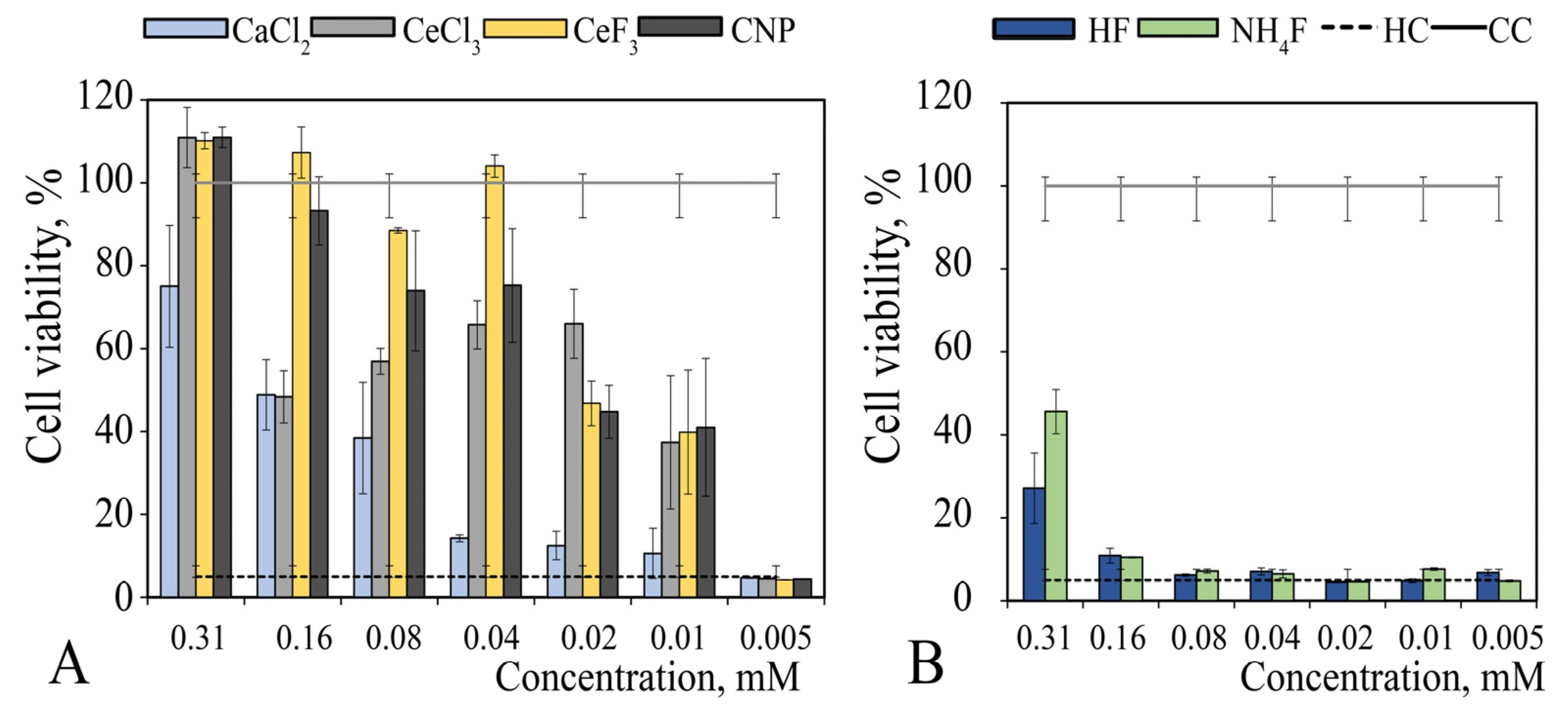
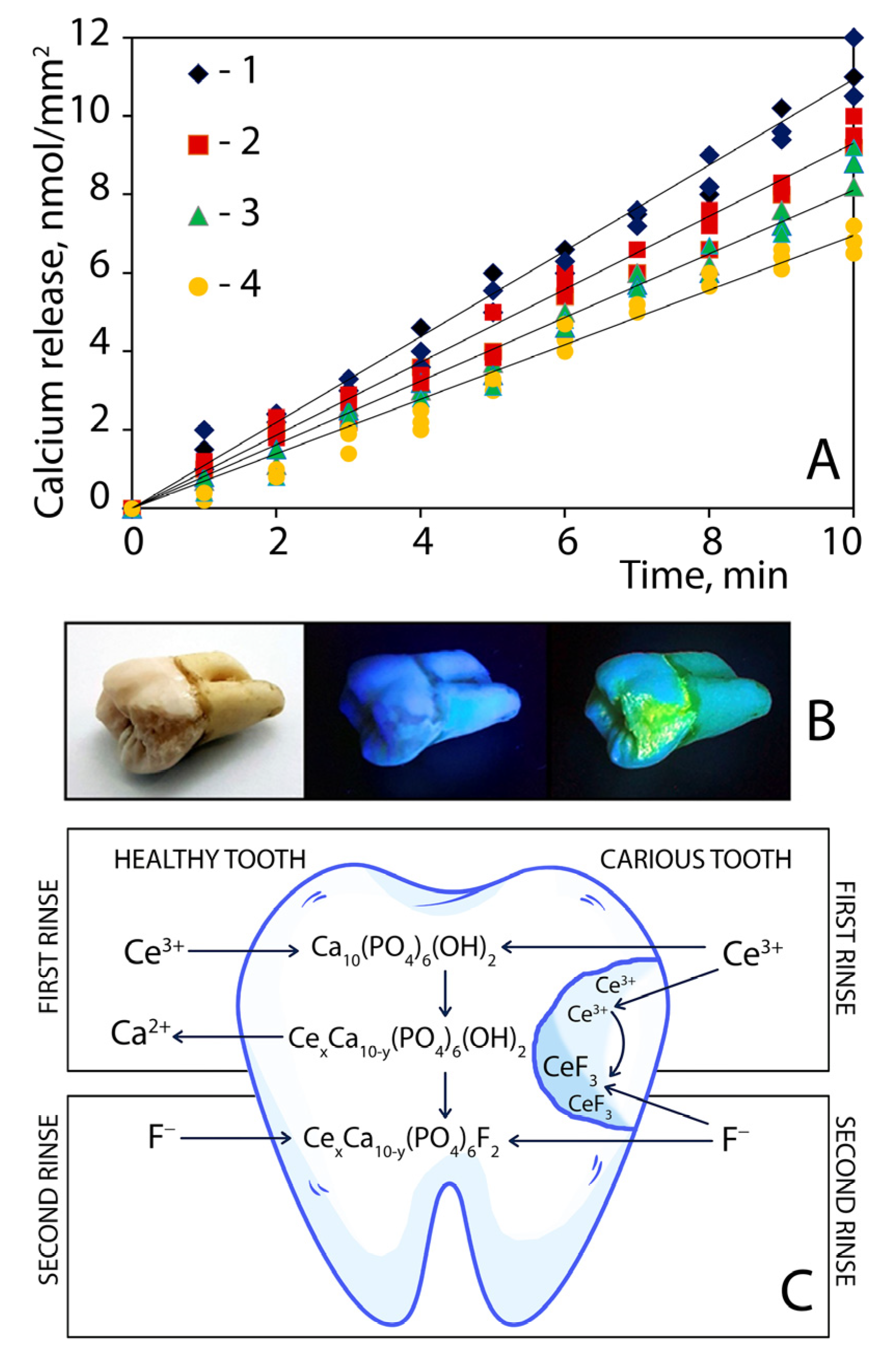

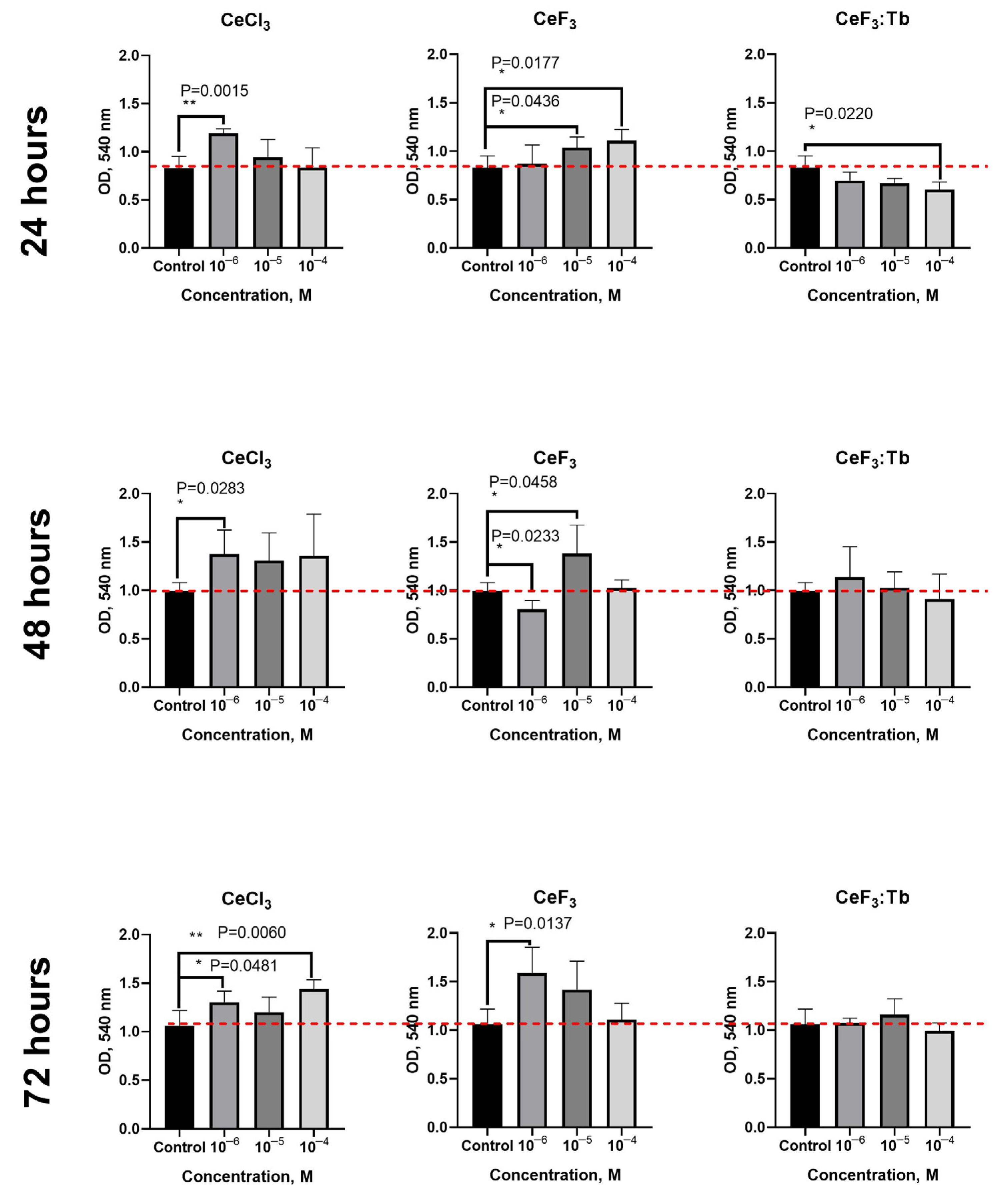
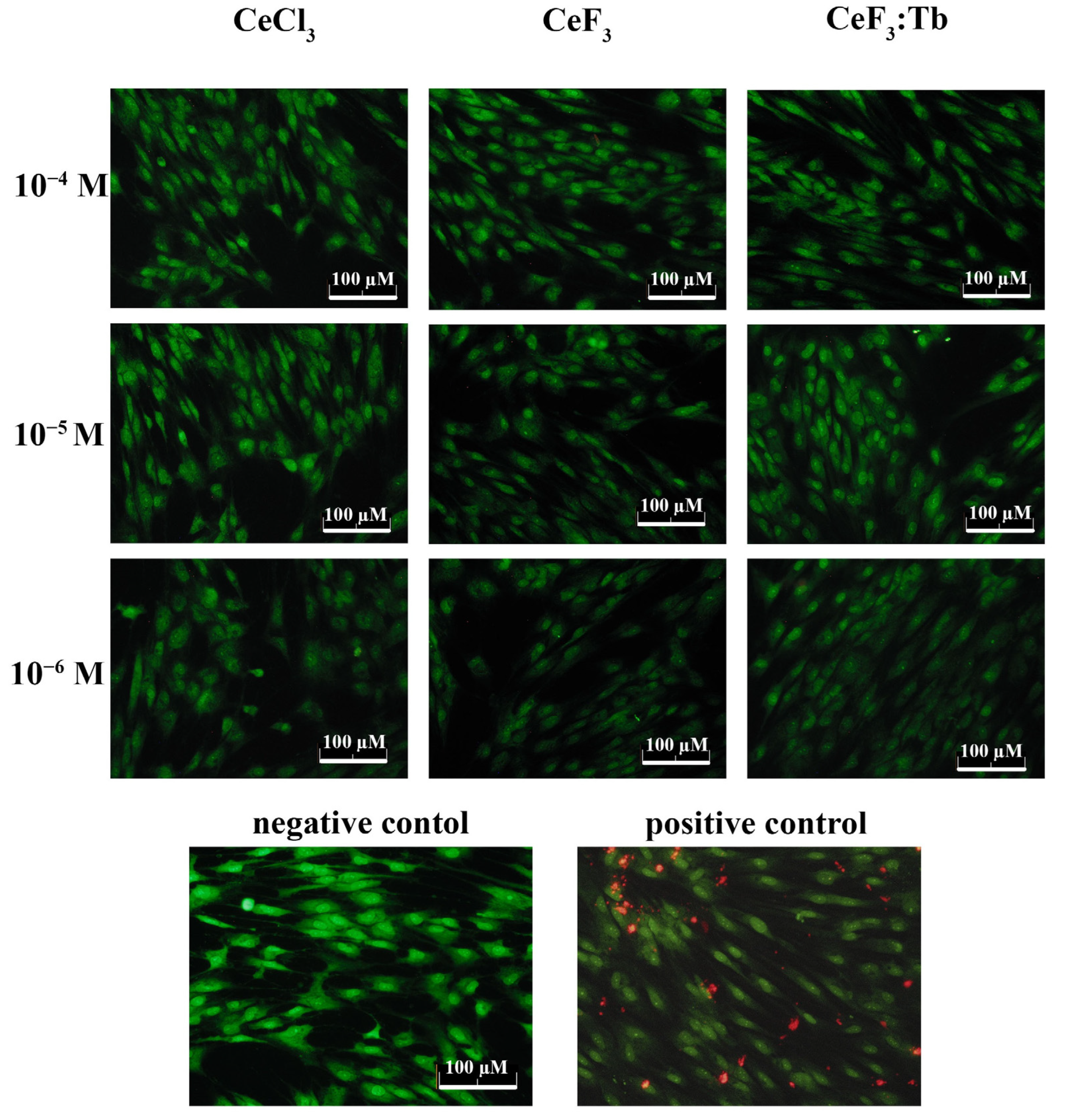


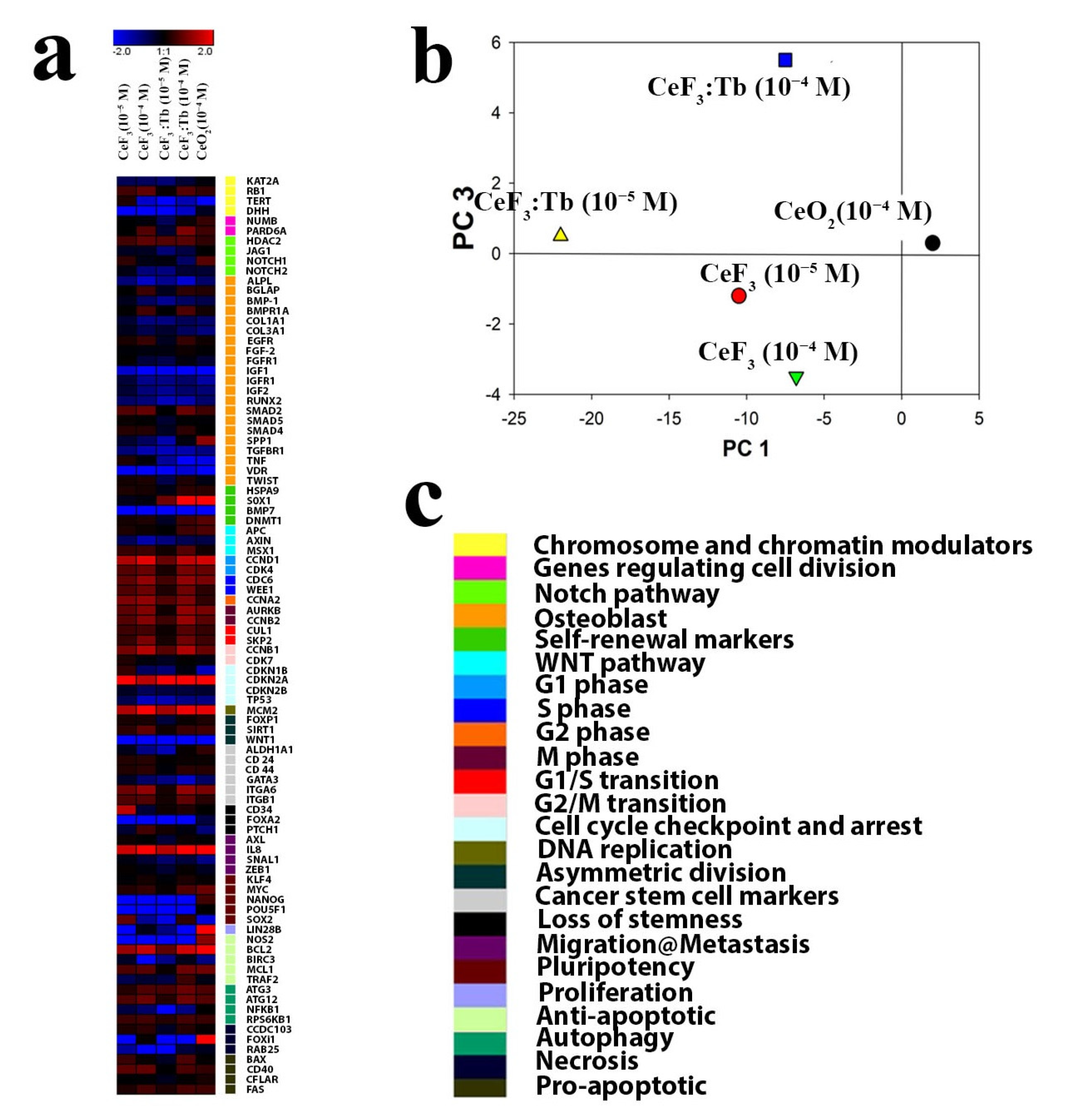
| Gene | Function | Gene | Function | Gene | Function |
|---|---|---|---|---|---|
| KAT2A | Chromatin and chromosome modulators | HSPA9 | Self-renewal markers | FOXA2 | Stemness reduction markers |
| RB1 | SOX1 | PTCH1 | |||
| TERT | BMP7 | CD34 | |||
| DNMT1 | |||||
| DHH | Regulators of cell division symmetry | AXL | Cell migration markers | ||
| NUMB | APC | Stemness maintenance (Wnt signalling) | IL8 | ||
| PARD6A | AXIN | SNAI1 | |||
| HDAC2 | Stemness maintenance (Notch signalling) | MSX1 | TWIST1 | ||
| JAG1 | CCND1 | Proliferation markers | ZEB1 | ||
| NOTCH1 | CDK4 | KLF4 | Pluripotency markers | ||
| NOTCH2 | CDC6 | MYC | |||
| ALPL | WEE1 | NANOG | |||
| BGLAP | Markers of MSCs and their differentiation | CCNA2 | POU5F1 | ||
| BMP1 | AURKB | SOX2 | |||
| BMPR1A | CCNB2 | NOS2 | Anti-apoptotic markers | ||
| COL1A1 | CUL1 | BCL2 | |||
| COL3A1 | SKP2 | BIRC3 | |||
| EGFR | CCNB1 | MCL1 | |||
| FGF-2 | CDK7 | TRAF2 | |||
| FGFR1 | CDKN1B | ATG3 | Autophagy markers | ||
| IGF1 | CDKN2A | ATG12 | |||
| IGFR1 | CDKN2B | NFKB1 | |||
| RUNX2 | TP53 | RPS6KB1 | |||
| SMAD2 | MCM2 | CCDC103 | Necrosis markers | ||
| SMAD4 | LIN28B | FOXI1 | |||
| SMAD5 | FOXP1 | Markers of asymmetric cell division | JPH3 | ||
| SPP1 | SIRT1 | RAB25 | |||
| TGFBR1 | WNT1 | BAX | Pro-apoptotic markers | ||
| TNF | ALDH1A | Stemness markers | CD40 | ||
| VDR | CD44 | CFLAR | |||
| GATA3 | FAS | ||||
| ITGA6 | TNFRSF10A | ||||
| ITGB1 |
Publisher’s Note: MDPI stays neutral with regard to jurisdictional claims in published maps and institutional affiliations. |
© 2022 by the authors. Licensee MDPI, Basel, Switzerland. This article is an open access article distributed under the terms and conditions of the Creative Commons Attribution (CC BY) license (https://creativecommons.org/licenses/by/4.0/).
Share and Cite
Popov, A.L.; Zholobak, N.M.; Shcherbakov, A.B.; Kozlova, T.O.; Kolmanovich, D.D.; Ermakov, A.M.; Popova, N.R.; Chukavin, N.N.; Bazikyan, E.A.; Ivanov, V.K. The Strong Protective Action of Ce3+/F− Combined Treatment on Tooth Enamel and Epithelial Cells. Nanomaterials 2022, 12, 3034. https://doi.org/10.3390/nano12173034
Popov AL, Zholobak NM, Shcherbakov AB, Kozlova TO, Kolmanovich DD, Ermakov AM, Popova NR, Chukavin NN, Bazikyan EA, Ivanov VK. The Strong Protective Action of Ce3+/F− Combined Treatment on Tooth Enamel and Epithelial Cells. Nanomaterials. 2022; 12(17):3034. https://doi.org/10.3390/nano12173034
Chicago/Turabian StylePopov, Anton L., Nadia M. Zholobak, Alexander B. Shcherbakov, Taisiya O. Kozlova, Danil D. Kolmanovich, Artem M. Ermakov, Nelli R. Popova, Nikita N. Chukavin, Ernest A. Bazikyan, and Vladimir K. Ivanov. 2022. "The Strong Protective Action of Ce3+/F− Combined Treatment on Tooth Enamel and Epithelial Cells" Nanomaterials 12, no. 17: 3034. https://doi.org/10.3390/nano12173034
APA StylePopov, A. L., Zholobak, N. M., Shcherbakov, A. B., Kozlova, T. O., Kolmanovich, D. D., Ermakov, A. M., Popova, N. R., Chukavin, N. N., Bazikyan, E. A., & Ivanov, V. K. (2022). The Strong Protective Action of Ce3+/F− Combined Treatment on Tooth Enamel and Epithelial Cells. Nanomaterials, 12(17), 3034. https://doi.org/10.3390/nano12173034













